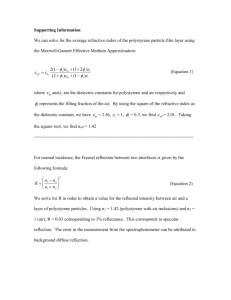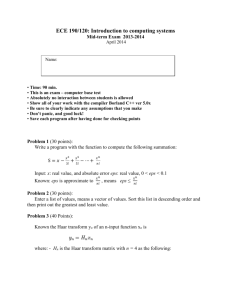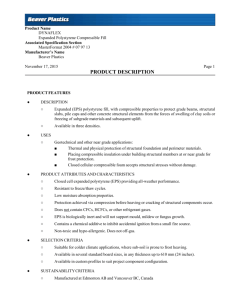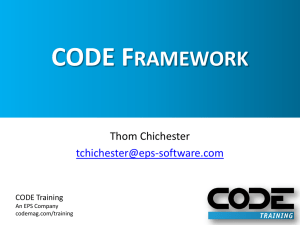the importance of expanded polystyrene in long span structures
advertisement
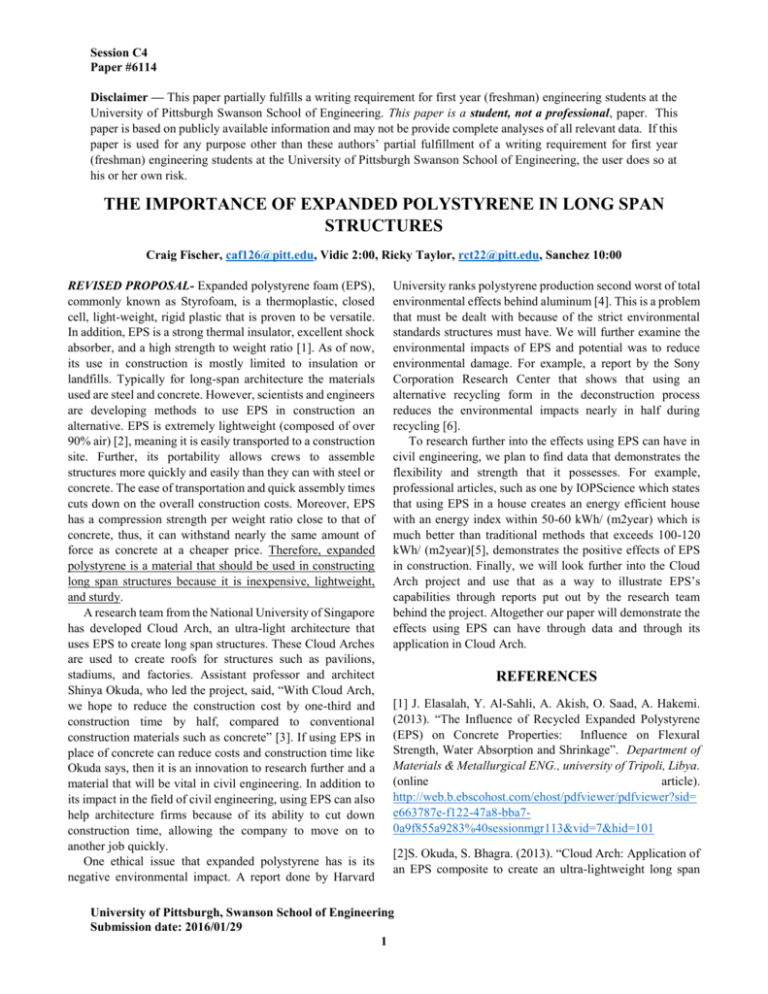
Session C4 Paper #6114 Disclaimer — This paper partially fulfills a writing requirement for first year (freshman) engineering students at the University of Pittsburgh Swanson School of Engineering. This paper is a student, not a professional, paper. This paper is based on publicly available information and may not be provide complete analyses of all relevant data. If this paper is used for any purpose other than these authors’ partial fulfillment of a writing requirement for first year (freshman) engineering students at the University of Pittsburgh Swanson School of Engineering, the user does so at his or her own risk. THE IMPORTANCE OF EXPANDED POLYSTYRENE IN LONG SPAN STRUCTURES Craig Fischer, caf126@pitt.edu, Vidic 2:00, Ricky Taylor, rct22@pitt.edu, Sanchez 10:00 REVISED PROPOSAL- Expanded polystyrene foam (EPS), commonly known as Styrofoam, is a thermoplastic, closed cell, light-weight, rigid plastic that is proven to be versatile. In addition, EPS is a strong thermal insulator, excellent shock absorber, and a high strength to weight ratio [1]. As of now, its use in construction is mostly limited to insulation or landfills. Typically for long-span architecture the materials used are steel and concrete. However, scientists and engineers are developing methods to use EPS in construction an alternative. EPS is extremely lightweight (composed of over 90% air) [2], meaning it is easily transported to a construction site. Further, its portability allows crews to assemble structures more quickly and easily than they can with steel or concrete. The ease of transportation and quick assembly times cuts down on the overall construction costs. Moreover, EPS has a compression strength per weight ratio close to that of concrete, thus, it can withstand nearly the same amount of force as concrete at a cheaper price. Therefore, expanded polystyrene is a material that should be used in constructing long span structures because it is inexpensive, lightweight, and sturdy. A research team from the National University of Singapore has developed Cloud Arch, an ultra-light architecture that uses EPS to create long span structures. These Cloud Arches are used to create roofs for structures such as pavilions, stadiums, and factories. Assistant professor and architect Shinya Okuda, who led the project, said, “With Cloud Arch, we hope to reduce the construction cost by one-third and construction time by half, compared to conventional construction materials such as concrete” [3]. If using EPS in place of concrete can reduce costs and construction time like Okuda says, then it is an innovation to research further and a material that will be vital in civil engineering. In addition to its impact in the field of civil engineering, using EPS can also help architecture firms because of its ability to cut down construction time, allowing the company to move on to another job quickly. One ethical issue that expanded polystyrene has is its negative environmental impact. A report done by Harvard University ranks polystyrene production second worst of total environmental effects behind aluminum [4]. This is a problem that must be dealt with because of the strict environmental standards structures must have. We will further examine the environmental impacts of EPS and potential was to reduce environmental damage. For example, a report by the Sony Corporation Research Center that shows that using an alternative recycling form in the deconstruction process reduces the environmental impacts nearly in half during recycling [6]. To research further into the effects using EPS can have in civil engineering, we plan to find data that demonstrates the flexibility and strength that it possesses. For example, professional articles, such as one by IOPScience which states that using EPS in a house creates an energy efficient house with an energy index within 50-60 kWh/ (m2year) which is much better than traditional methods that exceeds 100-120 kWh/ (m2year)[5], demonstrates the positive effects of EPS in construction. Finally, we will look further into the Cloud Arch project and use that as a way to illustrate EPS’s capabilities through reports put out by the research team behind the project. Altogether our paper will demonstrate the effects using EPS can have through data and through its application in Cloud Arch. REFERENCES [1] J. Elasalah, Y. Al-Sahli, A. Akish, O. Saad, A. Hakemi. (2013). “The Influence of Recycled Expanded Polystyrene (EPS) on Concrete Properties: Influence on Flexural Strength, Water Absorption and Shrinkage”. Department of Materials & Metallurgical ENG., university of Tripoli, Libya. (online article). http://web.b.ebscohost.com/ehost/pdfviewer/pdfviewer?sid= e663787e-f122-47a8-bba70a9f855a9283%40sessionmgr113&vid=7&hid=101 [2]S. Okuda, S. Bhagra. (2013). “Cloud Arch: Application of an EPS composite to create an ultra-lightweight long span University of Pittsburgh, Swanson School of Engineering Submission date: 2016/01/29 1 Craig Fischer Ricky Taylor sustainable structure”. Faculty of Architecture, Delft University of Technology. (online article). http://repository.tudelft.nl/search/conferencepapers/?q=title %3A%22Cloud%20Arch%3A%20Application%20of%20an %20EPS%20composite%20to%20create%20an%20ultralightweight%20long-span%20sustainable%20structure%22 Strength, Water Absorption and Shrinkage”. Department of Materials & Metallurgical ENG., university of Tripoli, Libya. (online article). http://web.b.ebscohost.com/ehost/pdfviewer/pdfviewer?sid= e663787e-f122-47a8-bba70a9f855a9283%40sessionmgr113&vid=7&hid=101 This article, from a professional, peer-reviewed paper from the University of Tripoli, Libya, details the effects adding expanded polystyrene can have on lightweight concrete. The article also provides an introduction to what expanded polystyrene is and the qualities that it has. Information from this article will help us to introduce expanded polystyrene as a possible alternative construction material. [3] M. Manibo. (2014). “Singapore researchers unveil new light-as-cloud architectural technology”. Eco-Business. (online article). http://www.ecobusiness.com/news/singapore-researchers-unveil-new-lightas-cloud-architectural-technology/ [4] (2008). “Polystyrene Facts Sheet”. Harvard University. (online pdf). http://isites.harvard.edu/fs/docs/icb.topic967858.files/Polyst yreneFactSheets.pdf “Long-span construction: Ultra-light-weight cloud arch architectural technology for sustainable construction”. (2014). National University of Singapore. (online article). http://www.scienceday.com/releases/2014/10/141010084045 .htm This article, from a professional, peer reviewed paper from the National University of Singapore outlines the goal and project that the research team is working on at the university. It describes the Cloud Arch technology and the use of EPS within the project. We will use this source to learn more about Cloud Arch and its uses in construction and the role EPS plays in its construction. [5] J. Alexandre , A.R.G. Azevedo, C.L. de Assis Paula e Silva Silva , C.M.F. Vieira , V.S. Candido , & S.N. Monteiro. (2014). “Technical feasibility of using lightweight concrete with expanded polystyrene in civil construction”. Materials Science Forum. (online article). http://iopscience.iop.org/article/10.1088/1757899X/71/1/012002/pdf. [6] T. Noguchi, H. Tomita, K. Satake, H. Watanabe. (1998). “New recycling system for expanded polystyrene using a natural solvent. Part 3. Life cycle assessment”. Sony Corporation Research Center (online article). http://onlinelibrary.wiley.com/doi/10.1002/(SICI)10991522(199802)11:1%3C39::AID-PTS416%3E3.0.CO;2Y/abstract M. Manibo. (2014). “Singapore researchers unveil new lightas-cloud architectural technology”. Eco-Business. (online article). http://www.eco-business.com/news/singaporeresearchers-unveil-new-light-as-cloud-architecturaltechnology/ In this professional business article, the technology is described in detail. The author thoroughly explains the uses and developments surrounding the innovation—in roofing structures--, and explains the economic advantages and time reduction. . The author also lists a few disadvantages, specifically those to the environment such as disposal errors and production waste that harms the environment. These topics, both positive and negative, can be used effectively in this conference paper. ANNOTATED BIBLIOGRAPHY J. Alexandre , A.R.G. Azevedo, C.L. de Assis Paula e Silva Silva , C.M.F. Vieira , V.S. Candido , & S.N. Monteiro. (2014). “Technical feasibility of using lightweight concrete with expanded polystyrene in civil construction”. Materials Science Forum. (online article). http://iopscience.iop.org/article/10.1088/1757899X/71/1/012002/pdf. This article, from a professional, peer-reviewed paper from the Technical University of Kosice, Slovakia, details information on the different materials used to build houses and compares them against each other. The article outlines the positive effects using expanded polystyrene as a construction material brings. This article has certain data that will help us describe the positive effects EPS has through its energy consumption compared to other materials. T. Noguchi, H. Tomita, K. Satake, H. Watanabe. (1998). “New recycling system for expanded polystyrene using a natural solvent. Part 3. Life cycle assessment”. Sony Corporation Research Center (online article). http://onlinelibrary.wiley.com/doi/10.1002/(SICI)10991522(199802)11:1%3C39::AID-PTS416%3E3.0.CO;2Y/abstract This professional, science article was found in a textbook on packaging technology and science. This paper discusses a new innovative technique for recycling and disposing of the polystyrene by using a series of chemical treatments that are nontoxic to the environment. This source will also contribute to the argument against the environmental impacts posed by J. Elasalah, Y. Al-Sahli, A. Akish, O. Saad, A. Hakemi. (2013). “The Influence of Recycled Expanded Polystyrene (EPS) on Concrete Properties: Influence on Flexural 2 Craig Fischer Ricky Taylor this material, as it will reduce the waste in landfills and pollution within the environment. S. Okuda, S. Bhagra. (2013). “Cloud Arch: Application of an EPS composite to create an ultra-lightweight long span sustainable structure”. Faculty of Architecture, Delft University of Technology. (online article). http://repository.tudelft.nl/search/conferencepapers/?q=title %3A%22Cloud%20Arch%3A%20Application%20of%20an %20EPS%20composite%20to%20create%20an%20ultralightweight%20long-span%20sustainable%20structure%22 This source is a peer written abstract proposal for a conference paper. The article calls for the transition of use of polystyrene to switch from insulation and landfills, to uses such as roofing structures, altered to fit fire code standards and have the strength and durability to last as such. The topics of this proposal directly correlate to this proposal and offer a further investigation into topics of discussion. (2008). “Polystyrene Facts Sheet”. Harvard University. (online pdf). http://isites.harvard.edu/fs/docs/icb.topic967858.files/Polyst yreneFactSheets.pdf This source is a PDF file published by Harvard students and staff to describe the harmful effects this product has on the environment. The fact sheet lists all the harmful effects on the environment and pollution of sea, land, and air. The information presented in this article offers a rebuttal to our proposal, and a challenge to find a solution to argue for the advancement of this technology. “Selecting a topic video”. (2015). University of Pittsburgh library resources. (online video). http://www.library.pitt.edu/other/files/il/fresheng/index.html This online video from the University of Pittsburgh library outlines the steps to choose a topic. It introduces the various databases available to students. It also provides examples of the correct way to use the resources that will lead to success. Although not directly related to the topic it is an important source as it pointed us in the right direction and taught us how to use our resources. 3
